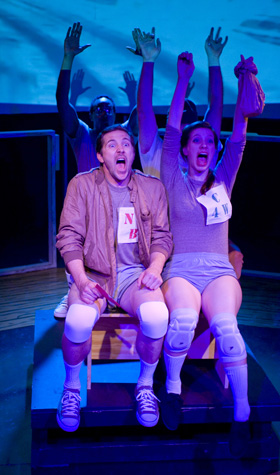
We think of America in the 1950s as a sedentary age, when the upheaval of two world wars and the Great Depression gave way to an atmosphere of placid security. This impression, it must be noted, is chiefly based in commercial images spawned by the boom economy and promoted by an advertising industry coming into its own as the powerful social influence it is today.
Far from reflecting leisurely lifestyles, the universe of Rolin Jones' The Jammer is defined by its steadily-increasing velocity. Our humble hero begins his journey as a taxicab driver in Brooklyn looking forward to nothing more than a contented future with his likewise unremarkable sweetheart, until a promoter persuades him to seek his fortune in the (literal) fast-track world of competitive skating.
Before long, we find him dashing from one tournament to the next on the bus that he shares with a pack of borderline psychopaths united in their quest for fame through the quasi-gladiatorial spectator sport popularized under the name of "Roller Derby." It doesn't stop there, either—when our bruised and battered protagonist finally meets his moment of truth, it occurs high atop a Coney Island roller-coaster.
Did I mention that the stage for this Pine Box Theater production is only 24 feet wide and 20 feet deep?
"There is plenty of athletic spectacle within the confines we've given ourselves," director Vincent Teninty assures those skeptical of his company's ability to bring off this early work by the author of The Intelligent Design of Jenny Chow, "The play is more about the characters' relationships than it is about Roller Derby—which is simply the frame for this group of outcasts growing to love and appreciate each other. I never asked how many people in the cast actually knew how to skate. The goal of [movement choreographer] Matt Hawkins and the production team was to create the impression of professional skaters, while allowing the actors to engage one another without losing focus."
Rolin Jones is a playwright fond of writing his own stage directions. Did these include the routes of the various vehicles—the roller-coaster, in particular, where the centrifugal pulls occur abruptly and everyone must respond simultaneously.
"Jones includes a lot of stage directions, it's true," Teninty admits, "but for the roller coaster scene, he just specified when it climbs and plummets. I directed the movement on the vehicles, but the actors and I, together, sat through each sequence to find the best times for the turns and whoopsies."
Did the roller-coaster riders rehearse their responses in silence first and add the gasps, screams, etc. later on, the way it's done in stage combat? "For the most part, everything was rehearsed with spoken dialogue from the start," Teninty recalls, "This cast works incredibly well as an ensemble. Their positive energy and their willingness to follow instruction made the entire show fun to direct."
Pine Box Theater's production of The Jammer runs at the Athenaeum through July 1.
Mary Shen Barnidge
Contributing Writer

 Follow Us On Twitter
Follow Us On Twitter